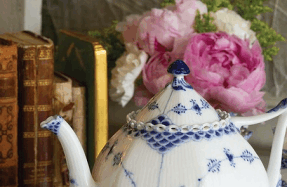
The ladies of colonial Boston and New York were addicted to their tea ritual in much the same manner as their cousins back in London and Amsterdam. Chinese tea was drunk in the morning at home and socially in the afternoon or early evening. Benjamin Franklin states, “At least a Million Americans drink Tea twice a Day.”
America’s taste for tea and other British goods caught the attention of cash-strapped Parliament as they looked for ways to pay for England’s involvement in the Seven Years War.

In 1765, Parliament enacted the Stamp Act. This scheme required all printed materials to be produced on material bearing an official stamp to show it had been duly taxed. Through-out the American colonies, resistance to this “taxation without representation” ran high, and angry protests were carried out. Consequently, sales of British goods in the colonies plummeted.
Parliament did away with the unpopulartax in March 1768, but the damage had beendone. British tea was avoided, and secret groups of men in numerous Americantowns formed to resist the “tyranny” of British rule. Those societies took on the common name “Sons of Liberty.” Harvard graduate Samuel Adams led Boston’s men.
As Dutch tea was smuggled into the colonies and sales of British tea ground to a near halt, the British East India Company continued to stockpile Chinese tea in its London warehouses, filling them to capacity. Alas, the stored tea would not last indefinitely; some approached five years of age. Without the American market, the mighty East India Company was headed toward failure.
Under pressure caused by an American boycott of all British imports, Parliament eventually repealed all their governing acts—save the 3-pence-per-pound tax on tea, which was retained as a symbol of Parliament’s authority over their American subjects. It was a small amount, but colonists found it






